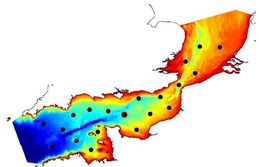Development of a Regional Sediment Mobility Model for Submerged Archaeological Sites
Justin Dix, 2010. https://doi.org/10.5284/1000118. How to cite using this DOI
Data copyright © Dr Justin Dix unless otherwise stated
This work is licensed under the ADS Terms of Use and Access.
Primary contact
Dr
Justin
Dix
Lecturer
Ocean and Earth Science
University of Southampton
Avenue Campus
Highfield
Southampton
SO17 1BJ
England
Tel: 023 8059 3057
Resource identifiers
- ADS Collection: 977
- ALSF Project Number: 5224
- DOI:https://doi.org/10.5284/1000118
- How to cite using this DOI
Introduction
An understanding of the dynamics of underwater archaeological sites has been a primary research aim of marine archaeologists for the last four decades. To develop a viable sediment dynamic model for artefact based sites is crucial both in terms of site formation process study; a priori archaeological investigation; and latterly the effective management of marine sites to ensure their future stability.

Previous ALSF project work (3365 Modelling Exclusion Zones for Marine Aggregate Dredging) did review, identify and study the process that govern the accumulation or erosion of sediments from around shipwreck sites. Understanding such local processes and their physical result (up to a few tens or hundreds of meters from the site) is of benefit to many diverse and large user-groups, including:
- Heritage managers, undertaking site preservation works.
- Archaeologists, interpreting geophysical data and predicting dispersal of artefacts.
- Marine ecologists, prediction of local habits.
- The dredging industry, interpreting the sedimentary environment and enabling efficient design of exclusion zones.
- Marine engineers, understanding generic local response of the seabed to the introduction of three-dimensional structures.
These previous site specific studies have highlighted the need for information about the temporal and spatial variance in the input rates of sediments from outside of the site, controlled by processes occurring at a regional scale. In this project we apply one of the leading commercial numerical hydrodynamic modelling products, DHI's MIKE 21 software, to the development of regional scale models of seabed sedimentation and erosion. The results provide a means to estimate or predict the tidal and sedimentary environment at a regional scale which may then be used, either in its own right or in conjunction with site specific work, to further enhance the understanding and effectiveness of the user groups described above.
The model provides results at a resolution of approximately 5km over the whole of the English Channel and southern North Sea. The information produced by the model includes:
- Orientation of the tidal axis
- Residual tidal flow direction and magnitude
- Residual sediment transport direction and magnitude
- Magnitude and asymmetry of sediment transport
- Tendency towards regional-scale net bed accumulation or erosion.
On the basis of all results, regions of the English Channel and the English coastline (5-20km offshore) can be categorised according to the predicted strength of sediment mobility (the average strength of sediment transport) and the asymmetry of that transport. Conceptual models are proposed to allow extension of the predicted environmental conditions to predicting wreck site response and the conditions of debris dispersal. The model demonstrated that temporal variability is present in the system at semi-diurnal (half-daily), spring-neap (two-weekly) and equinoxal (six-monthly) timescales. However, the model also suggests that variability is generally confined to the magnitude of the response; the direction (e.g. of residual transport) or sign (erosion or accumulation) of response is consistent over time.
The relative results describe the outline shape of present day major sand body accumulations in the English Channel; however, insufficient data regarding distribution of grain size and the thickness of sediment layers was available at the scale of the English Channel, to quantitatively define or predict the boundaries. The model considers only tidal forcing (the dominant factor in water depths deeper than 20m); therefore, results from shallower depth regions (generalised here as within 5km of the coastline) are excluded from the interpretation.
The model was designed and calibrated using a variety of, but limited number and coverage of data sets from the field; it was identified that large scale calibration would be improved by the collection of dedicated data for this purpose in offshore locations throughout the English Channel. It was also demonstrated, through the application of more detailed input data in two smaller sub-areas, that the accuracy and usefulness of the model results for license region sized areas may be improved in future studies by the provision of more detailed data, as it becomes available (e.g. as is collected during Environmental Assessment).







